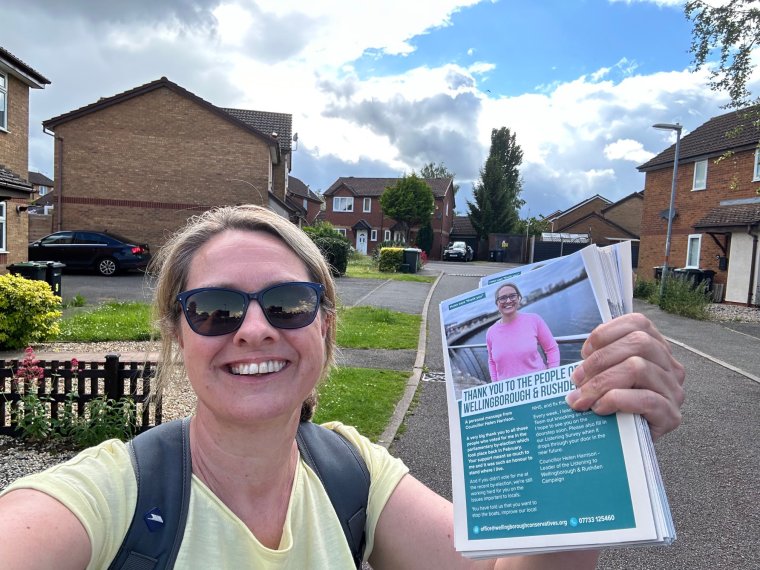Conservative Party headquarters appears to be taking a rather unorthodox approach to its general election campaign strategy – by arming candidates with leaflets that, at first glance, barely mention the party, or its leader.
The pamphlets, produced using templates provided to candidates from Conservative Campaign Headquarters, carry apparently minimal reference to their Tory origins and adopt a muted palate of hues including green and beige, rather than the more recognisable and on-brand blue.
Experts say the tactic is aimed at allowing candidates to establish themselves as a “local champion”, while still relying on the core Conservative vote at the ballot box. But critics say candidates are trying to distance themselves from the party’s current “unpopularity” in the polls.
The series of “introductory leaflets” being distributed in the initial skirmishes of general election campaigning includes a magazine-style “People” pamphlet linking the party’s would-be MPs to their communities and claimed electoral achievements from education spending to battling inflation.
It is only on closer scrutiny of the very bottom right-hand corner of the “People” pamphlets that the Conservative party name and logo is to be discerned.
Mentions of Rishi Sunak also appear to be absent from the front page, although it is understood that the Prime Minister does feature prominently in the inside pages. A previous pre-election Conservative leaflet – “You and Your Family” – also trumpeted the Prime Minister’s economic plan on its cover.
Theo Clarke, the incumbent and Tory candidate for Stafford, was this week among those advertising what Conservative HQ described as “local leaflets promoting local Conservative candidates”.

Ms Clarke tweeted an image of herself with campaigners holding copies of the “People” pamphlet as well as a separate leaflet in an attractive, if not characteristically Conservative, green hue explaining her recent achievements on behalf of her constituents.
Candidates campaigning elsewhere in the country also posted photographs of similar leaflets. Tory councillor Helen Harrison, who is tipped to be the election candidate in Wellingborough, posted a photo of herself on the campaign trail with a leaflet that mentioned her party in the contact email address.
The Conservative Party – hitherto fans of a robustly blue leaflet bolstered by a sturdy oak emblem – told i that all its leaflets carried clear party branding.
i first reported this issue in February, after finding flyers for Conservative MPs that appeared to play down or almost obscure their party affiliation.
Seasoned campaigners pointed out at the time that in an era of general ennui with party politics, Tory spin doctors and communication gurus may have decided that voters are more likely to engage with election materials if they are seen to be less “tribalistic” and emphasise engagement with local issues while steering away from prominent branding.

A prime proponent of such reasoning would appear to be Nigel Gardner, the Tory candidate for the Hertfordshire seat of Harpenden and Berkhamsted. A leaflet produced for Mr Gardner, a public affairs specialist who was also once a spokesperson for the European Commission, focuses resolutely on local issues such as “council parking mayhem” and the future of Luton airport.
Philip Cowley, Professor of Politics at Queen Mary University, said there was “no great mystery” in the tactics being adopted by these candidates.
“You have an unpopular national party, and a candidate hoping that he or she can establish themselves as a local champion, while still relying on the core Conservative vote. I suspect if you looked closely, the focus is all on local stuff, rather than national policy. This is not the first time this has been done, and it won’t be the last.”
The Conservative Party’s opponents have suggested that candidates and Tory headquarters have decided that there might indeed be electoral virtue in making campaign materials as “non-Conservative” as possible.
With Sunak recently matching John Major and Jeremy Corbyn in one opinion poll with the lowest ever popularity rating for a party leader, Labour suggested that a number of would-be MPs may have decided that prominently advertising links to the Prime Minister may not be a cast-iron route to success at the ballot box.

A Labour Party spokesperson said: “Rishi Sunak has dropped to new depths of unpopularity, with his own campaign headquarters and candidates refusing to put Tory branding onto their leaflets. After 14 years of chaos, even the Conservatives have decided it’s time for change.”
Separate evidence suggests that prior to Mr Sunak’s decision to call the 4 July election, some Tory MPs were already displaying reticence about advertising their party affiliation.
Data compiled by Campaign Lab, which analyses electoral campaign methods, found that as of November last year just over half of all 350 Conservative MPs did not mention their party in their Twitter biographies. By comparison, only 10 per cent of Labour MPs did the same and zero Lib Dems.
It should also be pointed out that politicians from other parties have in the past shown themselves to be not above distancing themselves from their leadership.
An analysis by The Telegraph ahead of the 2019 general election found that nine out of 10 Labour leaflets handed out in London, including on behalf of members of the then Shadow Cabinet, neglected to make any of mention the Labour leader at the time, Jeremy Corbyn.
In response to questions about its leaflets, a Conservative Party spokesperson said: “These photos only show the front page of local leaflets promoting local Conservative candidates. All leaflets are clearly Conservative Party branded and one of a wide number of leaflets that will be issued during the campaign.”
Election 2024
The general election campaign has finished and polling day has seen the Labour Party romp to an impressive win over Rishi Sunak‘s Tories.
Sir Keir Starmer and other party leaders have battled to win votes over six weeks, and i‘s election live blog covered every result as it happened. Tory big beasts from Penny Mordaunt to Grant Shapps saw big losses, while Jeremy Corbyn secured the win in Islington North.
Nigel Farage’s Reform UK also outdid expectations with four MPs elected.
But what happens next as Labour win? Follow the i‘s coverage of Starmer’s next moves as the new Prime Minister.

